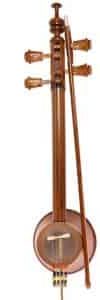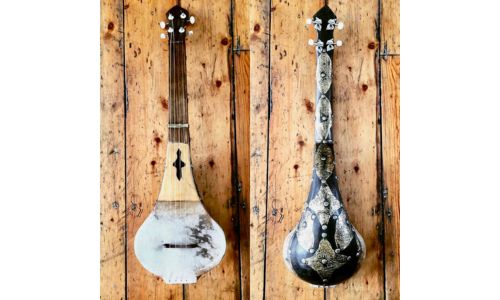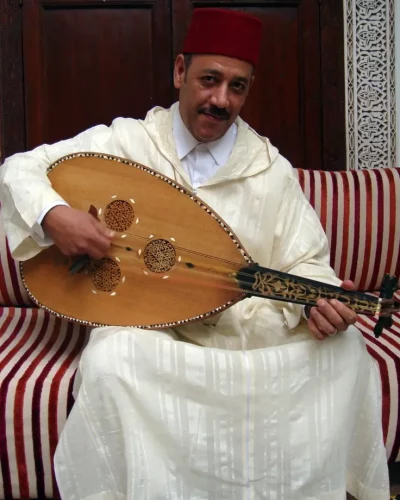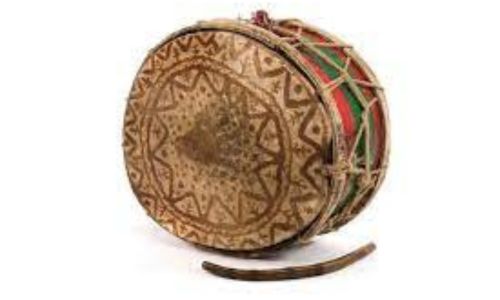17 Traditional moroccan musical instruments
List of traditional moroccan instruments used in the different styles of Moroccan music.
Contents
1 String moroccan instruments
2 Percussion moroccan instruments
3 Wind moroccan instruments or aerophones
String moroccan instruments
1. The kamanja
Also called kemanche, or kamānche, stringed instrument of the fiddle family prominent in Arab and Persian art music. It is a spike fiddle; i.e., its small, round or cylindrical body appears skewered by the neck, which forms a “foot” that the instrument rests on when played. Measuring about 30 inches (76 cm) from neck to foot, it has a membrane belly and, commonly, two to four strings tuned in fourths or fifths. The musician, who plays while seated, rests the foot of the instrument on his knee. The kamanjā is played by soloists as well as in ensembles.

The kamanjā apparently originated in northern Persia and was mentioned by the 10th-century philosopher and music theorist al-Fārābī. Though still common in the Middle East and Central Asia, it has given way in North Africa to the European viola and violin, which are called kamanjās; however in keeping with traditional kamanjā playing style, the instrument is held vertically rather than horizontally.
Both the instrument and the name are widely diffused. In Central Asia, northern India, and Southeast Asia, spike fiddles closely resembling the kamanjā are common under the name rebab. The kamanjā is called rabāb in Turkey; there the derivative name kemençe is applied to a pear-shaped fiddle similar to the Greek lira.
2. The Loutar
The loutar or lotar1 (in Amazigh: luṭar) is a Berber plucked string instrument of the oud (lute) family, originated from Morocco. It is classically made of wood and piriform (elongated pear-shaped).

It is a stringed moroccan instrument that is attached to the oud (lute) family with strings parallel to a neck, originally with three single plucked strings, of the guembri family. The gumbri is a kind of lute, the body is made of a piece of cedar wood, hollowed out, pear-shaped or rounded, covered with a felted sheepskin and mounted with two or three strings. Today, it has nylon strings. It is mainly used in the Amazigh music of the Middle Atlas (Morocco), especially in Khenifra.
It is different from its cousin of the Near and Middle East, the oud, by the number of strings, indeed it has four single strings (and not double strings like the oud).
Loutar is a name derived from the classical Arabic Al-Watar and means string in Moroccan dialectal Arabic.
With three strings, the loutar was improved by the popular singer Mohamed Rouicha who added a fourth string.
3. The qanûn
Arabic qanuns are generally constructed with five skin inserts that support a single long bridge resting on five arched pillars, while the slightly smaller Turkish qanuns have only four. This allows the Arabic variants of the instrument to have more room for the installation of extreme low and high strings. Qanuns made in Turkey generally have 26 rows of strings, with three strings per row in the case of all regional variants. Contemporary Arabic models use nylon or PVF strings that are stretched over the bridge stacked on fish skins as described at one end, and attached to wooden tuning pegs at the other end.
The ornamental sound holes called kafes are an essential part of what constitutes the usual timbre of the qanun. However, they normally occupy different locations on the soundboard of Turkish kanuns than Arabic qanuns, and may also vary in shape, size, and number depending on geography or personal taste.
The dimensions of a Turkish kanun are generally 95-100 cm (37-39″) in length, 38-40 cm (15-16″) in width, and 4-6 cm (1.5-2.3″) in height. In contrast, an Arabic qanun measures slightly larger as mentioned.
The qanun is played on the knees in a sitting or crouching position, or sometimes on a trestle, by plucking the strings with two tortoiseshell picks (one for each hand) or with the fingernails, and has a standard range of three and a half octaves from A2 to E6 which can be extended to F2 and up to G6 in the case of Arabic models.
The instrument also has special metal levers or latches under each course, called mandals. These small levers, which can be raised or lowered quickly by the performer while playing the instrument, are used to slightly alter the pitch of a particular course by changing the effective length of the strings.
4. The guembri
The guembri, gembri, gambri, guember or gumbri, is a plucked string moroccan musical instrument of the Gnaouas (“Guineans” in French). It is found mainly in North Africa in Morocco, Algeria (Diwane music), Tunisia (used in the stambali) and Mali where it was brought by the Gnaouas [ref. desired], descendants of slaves from Guinea. It is also played by the Tuaregs and the Berbers [ref. needed]. It is a derivative of the African n’goni.
The sintir, feel, el ajouj, or hajhouj, of larger size that is found in ecstatic Gnawa music is sometimes also called guembri. The gumbass is a variant of this instrument that combines the body of a guembri with the neck of an electric bass.
The Moroccan guember consists of a wooden neck with two pegs. The two strings of the guember are made from horse hair. The sound box is made of a tortoise shell with a resonance table made of a stretched skin.
Sonorized guembri used by jazzman Marcus Miller on his Afrodeezia tour in 2015.
Violin making: It is composed of a round wooden neck, sometimes turned and sometimes polychromatic, which is inserted into a monoxyle piriform resonance box made of poplar, whose sounding board is made with a stretched camel skin. This body, about 20 to 35 cm long, can also be made with the shell of a turtle. The three strings originally made of gut have been progressively replaced by nylon fishing line. The wooden pegs are carved with a penknife or roughly turned. A sistrum (sersèra) is inserted in the neck. The musical spectrum is placed in low frequencies.
The sintir has three strings* but no pegs to stretch them. Instead, there is a process of leather or nylon ties, similar to those found on the Kora. The sound box is more rectangular, almost square, with rounded corners, decorated with upholstery nails, and can be up to 55 or 60 cm long and 10 to 15 cm wide. The handle (for brooms) ends in a metal plate with rings that act as bells. The whole thing is over a meter long.
Playing. Accompanied by qraqeb (metal castanets) and a big drum, the guembri is played by the mâalem (the master) to guide the trance of the followers, during night rituals called lila mixing the festival (koyyou) and the therapeutic action (mlouk). The latter is supposed to allow the evacuation of the various ills from which the adept concerned suffers.
The sintir is played on a single melodic string, the other two being only drones played empty. It takes the place of a bass,
5. The rebab
The term rabâb or rubāb, roubab, robâb, rebâb, rbab, rubob, and rawap refers to two major families of stringed instruments originating in Persia that have a skin soundboard. The term is attested as early as the 10th century by the musicologist Farabi.
One distinguishes between hurdy-gurdies, instruments with bowed strings, and lutes, instruments with plucked strings. All these instruments have spread throughout the Muslim world and elsewhere, from Morocco to Indonesia, but curiously, the two families seem to be exclusive of each other, except in Iran.
Vielles
The family of vielles rabâb is rustic and ancient. There are two types:
large, with a long and thin neck, without fret, with three or four strings, with a spike, rather used in South Asian classical music or Middle Eastern folk music. It is then similar to the kamânche.
small, with a short and wide neck, without fret, monochord or bicord, used in North African folk and art music (Arabo-Andalusian music). It is then similar to the lyra.
6. The oud
The oud is a plucked string musical instrument widely used in Morocco. Its name comes from the Arabic al-oud (meaning “the wood”), a term transformed in Europe into laute, alaude, laud, liuto, and lute1. The Western lute is distinguished from it from the 14th century. In the Far East, it probably inspired the Chinese pipa (琵琶), in Japanese biwa.
A short-necked lute, it was the subject of reference works by Muslim musicologists in the medieval period. The oud has as commonalities with the lute the number of strings and the shape of the instrument, but it has no frets.

History: The oud has its cradle in Babylon, around 1800 BC, as discovered on a bas-relief of the temple of Hammurabi by the Iraqi researcher Anwar Rachidi. Present among the Assyrians, it appears in Egypt where it is found in the tomb of Ahmôsis (1500 BC). During the first pharaonic civilization, the Egyptians used the lute for their ceremonies and for their festivals.
It is likely that the first instruments were carved from a single piece of wood (neck and resonance box not separated), in the same way as the Chinese pipa (already present among the Tang (618-907) and the Northern Wei (386-534)) or the Japanese biwa (8th century), which are believed to be descendants of the barbat brought by the Silk Road.
The curved body served as a model for the European lute and mandolin, whose cases were constructed of numerous glued flexible wooden strips. The lute was transformed during the Renaissance and Baroque periods. The strings were played between the thumb and forefinger with the little finger resting on the table and the neck had gut-knotted frets so that polyphonic music could be played. At the end of the 16th century, a new form of 12-string lute appeared in England (theorbo and chitarrone) used more for accompaniment than for melody. It has constantly evolved, by adding low strings, until the eighteenth century.
Violin making. The oud consists of four major parts:
Soundboard made of softwood (nowadays mostly spruce, formerly cedar in the Near East and Morocco), traditionally unvarnished. The top is supported by a bracing of the same wood. It is pierced with large holes (1 or 3), often decorated with rosettes, in wood or bone. A wooden bridge is glued to it, as well as a reinforcement at the playing point.
Resonance box made of hard wood (walnut, mahogany, maple, beech are commonly used), it is pear-shaped and consists of fifteen or more ribs, forming the largest sounding box of all lutes.
Neck generally made in one of the woods of the soundbox, the neck is not fretted and is very short, like that of the violin, allowing to play the micro-intervals present in most maqamat also called A-dawr in Arabic: الدّور which means a rotation.
Peg the angle between the neck and the tailpiece is almost perpendicular, and this is of great importance to support the pressure of the eleven or twelve strings, held by wooden pegs similar to those of the violin. The nut is usually made of bone or ebony.
The violin maker tries to make the instrument as light as possible in order to make it as resonant as possible; the shape of the body allows for very thin wood thicknesses (about 1.5 mm). Thus, a good instrument weighs less than 1 kilogram.
The level of decoration of the oud (marquetry, inlays of mother-of-pearl, bone or ivory) varies according to the country of origin. Thus, ouds of Turkish origin are often very bare, and those of Egyptian origin often very decorated.
The strings were traditionally made of gut for the two or three highest pitched choruses, and spun copper on silk for the lowest. Today, they are generally made of nylon and spun nylon. The tension of the oud strings is notably lower than that of other instruments such as the guitar, typically 30 to 40 newtons.
Several types of ouds are used in Arab-Turkish music:
ud hanin is an oud specifically for soloing with a small, almond-shaped, single-rose body and a tinny sound.
ud rannan is a specific oud for ensemble music with a pear-shaped body, with three or five rosettes, very sonorous.
In the Maghreb one distinguishes between the Near Eastern oud, oud sharki, and the four-course oud of Arabo-Andalusian music, known as `ud rammal in Morocco, ud `arbî in Tunisia and in the Constantinois and finally kuitra in Algeria.
Play
The oud is held in the same way as a guitar, taking care to keep the face vertical so that it is not visible to the player; the weight must be supported by the thigh and the right arm so that the left hand is free to move on the neck. In the past, many players sat cross-legged on the floor; now most play sitting in a chair, often using a footrest under their right foot.
A long, flexible plectrum is used, putting the wrist at a particular angle that gives a certain sound and agility: the risha (“feather” in Arabic) or mezrab (in Turkish) is made of a thin slice of cow horn, a trimmed and flattened eagle feather or more prosaically a plastic pick. It is held between the thumb, the index and the little finger, to pluck the strings of the instrument according to two techniques: the simple or double pluck. A virtuoso oud player can be recognized by the balanced use of these two techniques. The thinner plucks give a very delicate sound, full of nuances, the heavier ones give a very strong sound. Players often use a plectrum with one end unaltered and the other thinned by him, allowing him to use the most appropriate shape for his needs.
The oud is a solo instrument of Arabic music par excellence, but it is also used as a melodic or rhythmic bass in instrumental ensembles, unless it accompanies a singer. The same is true of Turkish and Iranian music. But it is also in these countries, a very popular instrument, and lends itself to the whole folk repertoire. Similarly, in Greece and Armenia, it is rather confined to festive music.
One does not play chords on the oud, unlike the lute or the guitar. The music being modal, one never plays several notes at the same time, but in a very fast succession, except for the drone string. In addition, many oud players remove the last two strings, the highest ones, in order to facilitate the playing. Mounir Bachir has the particularity to put the low string below the others.
It is possible to tune an oud in many different ways.
7. The kuitra
The kuitra, kouitra or kwîthra is a musical instrument belonging to the cordophone family. It is a lute with a short neck similar to the oud. It is found since the eighteenth century in Algeria and where it is one of the symbols of Algerian music.
Lutherie
It has four double strings stretched on a pegbox bent in the old way (with friction pegs). The tuning is embraced (a string tuned to the octave adjoins another). The domed sounding board is reminiscent of the oud, but it has only one large central rosette on the soundboard. The fingerboard is smooth, without fret.
Playing
It is played with an eagle feather plectrum (rîsha). The tuning is: D – A – E – G or D – G – A – D.
The repertoire is exclusively that of the accompaniment in the nouba of the Arabo-Andalusian music. Among the greatest players of kouitra, the late Si Mohamed El Bahar occupies a particular place. Let us also quote Nour-Eddine Saoudi.
Percussion moroccan instruments
Probably the most widely known traditional moroccan instruments are percussion instruments.
8. The bendir
The bendir, bendayer or alloun (in Berber: ⴰⵍⵍⵓⵏ allun) is a percussion instrument very widespread in North Africa (more particularly in Tunisia, Algeria and Morocco), particularly in Berber music. It is a frame drum quite similar to the Asian daf, belonging to the membranophones.
Arabic speakers call it bendir. In Tamazight, several terms are used depending on the region, it is called alloun, but also tagenza (High Atlas), or adjoun (Rif)1, while the terms amendayer and abendayer, frequent in Kabylia, have given the word “bendir” in Arabic. The word “allun” is the most widespread word in Berber languages and is pronounced “adjoun” among the Rifans.
Facture
With an average diameter of about 40 cm, the bendir has a remarkable depth (width of the frame) of 15 cm. The frame is made of a hoop of micocoulier wood. A hole is made in it to facilitate the grip. It is equipped with a glued goat skin covering the entire frame. A gut string patch is attached along this skin, which gives it a buzzing sound and increases the generous bass. The bendirs are often very colorful but can be, like this one, made simply of wood, gut and unpainted skin.
Playing
It is played sitting or standing during festivities, with energetic clapping of the hands and fingers, sometimes with twirling movements around the thumb. The players have the same role of striking the bendir horizontally by hitting the skin from below.
The bendir is the king instrument of traditional festivals and dances, and is also widely used by women during Berber ceremonies. It is the basic instrument of Berber music.
9. The tabl
The tabl, also called tbïla, tbal, tbel or tobilat, is a Maghrebian percussion instrument. It is a pair of small timpani similar to the nagara. Widespread in Algeria, Tunisia and Morocco, they are also found in Yemen and Egypt, although in this country the same term also designates a variant of the darbouka and even the bass drum, close to the davul. This term is also the origin of the pair of Indian timpani called tabla.

Manufacture.
They are made of terracotta, one larger than the other, and the goat skins are fixed on the top with the help of an interlacing of leathers all around the vases. The dimensions are variable and range from 50 to 20 centimeters in diameter for the largest.
Played with bare hands, they are used in rural music and certain Sufi brotherhoods such as the Aïssawas. The most famous tabl player is Larbi Batma who played in the group Nass El Ghiwane.
10. The guedra
Percussion instrument made of a pottery with a large opening covered with a parchment skin painted with henna or natural dyes. Used in the Saharan regions by the “blue men”.
11. The qraqeb
Name generally given to the castanets or metal crotales in the various regions of Morocco.
12. The ((riqq))or ((rekk))
Classical percussion instrument very widespread in the Middle East
13. The Taârija and the darbouka
A taarija (plural: ta’arij) is a Moroccan membranophone (drum), single skin and tube, played singly, unlike the tabla, which is a pair of drums, and is related to the darbouka. While the tube may be metal (e.g., silver), it is typically made of baked clay.
In some areas, tara’ij are traditionally given to children at the holiday of Ashura; a boy’s drum has a plain baked-clay tube, and a girl’s drum is painted in brightly colored patterns. A woman wearing heavy make-up may be said to be painted “like a taarija of Ashura”
Wind moroccan instruments or aerophones
14. The nira
Reed flute with six to eight holes. Used mainly in the High Atlas and by the shepherds.
15. The ney
The image of the “whirling dervishes” in the schema best recalls the Mevlevi Sufi order. From the 1500s to the 1900s, this order was politically and artistically important and the dervish lodges were the places where a considerable amount of sacred and secular music was created. Sufism is a form of Islamic mysticism that takes many forms around the world. Among its essential rituals are zikr (which means “remembrance of God” in Arabic, a practice involving the intense and rhythmic recitation of God’s names) and sema, the whirling performed by devotees called “dervishes.” These practices are a means of self-discipline, spiritual fulfillment and reunion with God.
In Turkey, sema is a visual spectacle; dervishes dressed in long white robes spin for half an hour or more in perfect circles, one hand raised toward God, the other pointed toward the earth with musical accompaniment. The dervish lodges were closed in 1925 after the establishment of the Republic of Turkey and when they reopened, they functioned primarily as spaces for urban performance art and music.
16. The zamar
It is a doubled flute with 6 holes ending with big horns worked to bring out the noise. This instrument is handcrafted, it is composed of a head with whistles, a body with the 6 holes made of bamboo and at the end by carved and filed horns. The body and the head are traditionally bound with beeswax.
17. The ghayta
The rhaita or ghaita (Arabic: غيطة) is a double reed instrument from North Africa. It is nearly identical in construction to the Arabic mizmar and the Turkish zurna. The distinctive name owes to a medieval Gothic-Iberian influence.[1][2] In southern Iberia, various sorts of wind instruments, including the related shawm, are known as gaitas, but in northern Iberia gaita refers only to bagpipes.
The rhaita was featured in The Lord of the Rings soundtracks by Howard Shore, specifically in the Mordor theme. American composer John Corigliano calls one of the movements of his 1975 Concerto for Oboe and Orchestra “Rhaita Dance”, asking the oboist to imitate a rhaita by pushing the reed further into his or her mouth. In 1981 while composing the soundtrack to Altered States Corigliano again called for oboists to mimic the rhaita sound during Three Hallucinations.

